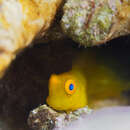Diagnostic Description
provided by Fishbase
Description: Dorsal fin IX-XI (usually X), 18-20, with short (9.2-14.2%SL) posteriormost ray; anal fin II, 18-20 (rarely 20); pectoral rays 15-18; pelvic fin I, 2; caudal fin segmented-rays 10-14; last dorsal ray joined to caudal fin but only scarcely; last anal ray may be barely connected also to the caudal fin but more often free. Supraorbital tentacle, slender and thread-like. Body deep, 3 in SL. (Ref. 90102). Several geographical variations. Adults almost black and some populations have a reddish tail. Juveniles often bright yellow (Ref. 48636).
Life Cycle
provided by Fishbase
Oviparous, distinct pairing (Ref. 205).
Morphology
provided by Fishbase
Dorsal spines (total): 9 - 11; Dorsal soft rays (total): 18 - 20; Analspines: 2; Analsoft rays: 18 - 20; Vertebrae: 33 - 35
Trophic Strategy
provided by Fishbase
Inhabits sheltered, shallow reefs, hiding among live or dead coral branches (Ref. 1602). From estuaries to outer reef lagoons (Ref. 48636).
- Recorder
- Grace Tolentino Pablico
Biology
provided by Fishbase
Adults inhabit sheltered, shallow reefs, hiding among live or dead coral branches (Ref. 1602). From estuaries to outer reef lagoons (Ref. 48636), 2-12 m deep. Solitary (Ref. 90102). Oviparous. Eggs are demersal and adhesive (Ref. 205), and are attached to the substrate via a filamentous, adhesive pad or pedestal (Ref. 94114). Larvae are planktonic, often found in shallow, coastal waters (Ref. 94114).
- Recorder
- Estelita Emily Capuli
Atrosalarias fuscus: Brief Summary
provided by wikipedia EN
Atrosalarias fuscus, also known as the dusky blenny, brown coral blenny or black blenny, is a species of marine fish in the family Blenniidae.
It is widespread throughout the tropical waters of the Indian Ocean, Red Sea included.
This fish is a small size that can reach a maximum size of 14.5 cm length.
- license
- cc-by-sa-3.0
- copyright
- Wikipedia authors and editors

